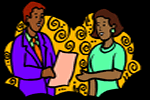






 |

Teacher Information
This lesson was developed as part of
Missouri's eMINTS Project (enhancing Missouri's Instructional Networked
Teaching Strategies). It was created to give students more insight on famous Missourians and why they are considered famous Missourians.
This lesson allows students to research and evaluate information to determine what makes a person "famous" in Missouri. It was created to show students that many people contributed to what Missouri is today, and that some people who are considered "famous" are not necessarily people who contributed to the success of Missouri.
Learners
This lesson is created for fourth grade social studies. It involves Missouri history. It can be adapted as needed to fit lower or higher grade levels and curriculum.
While students are researching information about their famous Missourian, the teacher may allow students from different groups to work together if they have the same famous Missourian. When students are filling out the checklist for each groups' movies, students may complete the checklist individually, with a partner, or with their whole group.
Students will need to be familiar with Windows Movie-Maker or some other movie-making software to create their movies.
Standards
Performance:
1.2: Students will conduct research to answer questions and evaluate information and ideas.
1.4: Students will use technological tools and other resources to locate, select and organize information.
1.8: Students will organizedata, information and ideas into useful forms (including charts, graphs, outlines) for analysis or presentation.
2.3: Students will exchange information, questions and ideas while recognizing the perspectives of others.
4.1: Students will explain reasoning and identify information used to support decisions.
Knowledge:
SS 2: Students will acquire knowledge about the continuity and change in the history of Missouri, the United States and the world.
CA 4: Students will acquire knowledge of and proficiency in writing formally (such as reports, narratives, essays) and informally (such as outlines, notes)
CA 5: Students will acquire knowledge of and proficiency in comprehending and evaluating the content and artistic aspects of oral and visual presentations (such as story-telling, debates, lectures, multi-media productions.)
CA 6: Students will acquire knowledge of and proficiency in participating in formal and informal presentations and discussions of issues and ideas.
NETS-S:
2a: Students interact, collaborate, and publish with peers, experts, or others employing a variety of digital environments and media.
2d: Students contribute to project teams to produce original works or solve problems.
3b: Students locate, organize, analyze, evaluate, synthesize, and ethically use information from a variety of sources and media.
3d: Students process data and report results.
4c: Students collect and analyze data to identify solutions and/or make informed decisions.
5b: Students exhibit a positive attitude toward using technology that supports collaboration, learning, and productivity.
|
In this activity, students are encouraged to make inferences, evaluate information, collaborate with peers, and use teamwork to create a project. |
